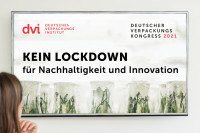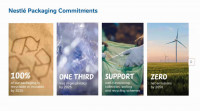The 15th German Packaging Congress took place for the first time as a virtual event under the motto “No lockdown for sustainability and innovation”. Numerous experts and leaders from business, politics and NGOs not only presented well-founded positions and opinions, but also argued about solutions, strategies and ways forward.
No recycled content and no debates going round in circles, instead many well-founded arguments, clear opinions and the common endeavour to identify and advance the best ways and solutions for more sustainability, circular economy and recycling: more than 350 participants made the first virtual German Packaging Congress of the German Packaging Institute e. V. (dvi) into a lively and rich industry summit.
“For all the differences in the strate-gies pursued and the solutions preferred, many commonalities emerged at the same time,” is how dvi Managing Director Kim Cheng sums up the industry summit. “In the fundamental endeavour for more sustainability, circular economy and recycling, the companies are pulling in the same direction. What is often missing is planning certainty, also due to a lack of political courage. This becomes clear, for example, when it comes to the use of recycled materials. Here, we are already much further ahead technologically than the political statements on this suggest”.
At the congress, it became clear that there is no one, beatific packaging material, neither for packaging manufacturers nor for brand companies and retailers. “For the immense and heterogeneous variety of products, we need the full range of materials,” Kim Cheng emphasized. “Regardless of the packaging material used, it shows that the principle of 3Rs – Reduce, Reuse, Recycle – is firmly embedded in companies’ strategies”.
According to Bernd Büsing, Head of Corporate Packaging at Nestlé Germany, there is also no silver bullet for sustainable packaging. What is needed, he says, is the interplay of several approaches and paths. For Nestlé, the defined goal is to make all packaging reusable or recyclable by 2025. As part of this, the use of virgin plastic is to be cut by a third and net climate emissions reduced to zero by 2050.
Nestlé’s strategic approach is based on five pillars. Pillar 1 is to reduce the amount of packaging in relation to the amount of material used. Pillar 2 is scaling up reusable or refillable packaging systems. This step also serves to reduce superfluous packaging volumes. Pillar 3 comprises pioneering work in the field of alternative packaging materials. The focus here is on simplifications and efficiency improvements in the recycling process. Pillar 4 includes support for the development of infrastructure for the circular eco-nomy. Finally, pillar 5 aims to establish and promote enlightened and responsible behaviour within the com-pany itself and among consumers, trading partners and suppliers.
A representative survey conducted by the dvi immediately prior to the congress shows that sustainability innovations relating to packaging are well received by consumers. At 44.0 %, around half of those surveyed said that packaging had made clear progress in terms of environmental friendliness over the past two to three years, with only 15.7 % seeing any regression.
In order to further anchor sustainability and to further promote the circular economy of packaging, the German Packaging Institute formulates four recommendations for action with regard to life cycle assessments, use of recycled materials, expansion of infrastructure and consumer appeal.
Life cycle assessments: politicians and NGOs must base their decisions and demands on life cycle assessment facts. Specifying a particular material or type of packaging is counterproductive. A real life cycle assessment includes, for example, the material input and the amount and type of energy used in production, but also in recycling, the weight and volume of the packaging as a factor in transport, the transport routes within the value chain, the use of water or chemicals for production or cleaning in the case of reusable packaging.
Increased use of recyclate: the use of recyclate is central. Especially in the case of plastics, cycles can only be closed if the packaging is not only collected and recycled, but the recyclate is also used for new packaging. Only when there is a functioning market for recyclate can the circle be closed. Here, too, it is above all the politicians who are called upon. There are various models for promoting the use of recyclate. What is needed is a clear path that provides planning security, ensures quality and product safety of the recyclate and significantly increases the amount of recyclate used.
Expansion of the infrastructure: the infrastructure of the circular economy must be further expanded. It is of little help if packaging is theoretically recyclable but recycling does not take place in the end. More capacities and innovative processes are needed to enable materials that could not previously be recycled to be recycled. The companies in the sector are doing their part here, for example through new processes or invisible codes that identify the respective materials of a package and enable efficient and seamless sorting.
Getting consumers on board: the circular economy can only work as a team of business, politicians and consumers. Consumers are a crucial element. Only what they dispose of correctly in the collection systems ultimately reaches the recycling plants. To make their task as easy as possible, packaging must clearly indicate how it is to be disposed of. In addition, it must be possible to easily separate the packaging components from different materials, if possible already in private households. Convenience in disposal is an important point. Consumers want solutions, not tasks.





